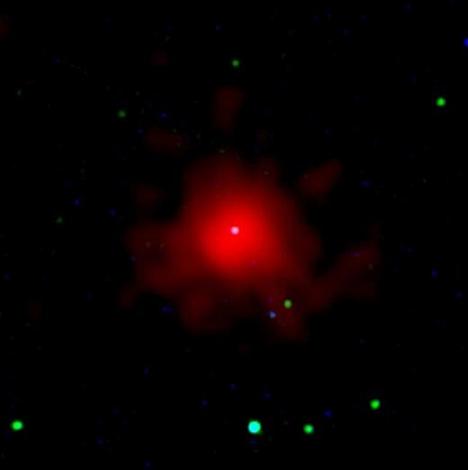C reative
Particle
Higgs
CPH Theory is based on Generalized light velocity from energy into mass.
CPH Theory in Journals
|
Molecules in Gamma-Ray Burst Detected
|
|
Written by Nancy Atkinson
This image merges Swift optical (blue, green) and X-ray views of GRB 080607. The white spot at center is the burst’s optical afterglow. Credit: NASA/Swift/Stefan Immler
Gamma-ray bursts are the universe's most brilliant events, and
now astronomers have been able to shed light on the composition
of these spectacular phenomena, providing insight into star
formation when the universe was about one-sixth its present age.
Combining data from NASA's Swift satellite, the W. M. Keck
Observatory in Hawaii, and other facilities astronomers have,
for the first time, identified gas molecules in the host galaxy
of a gamma-ray burst. "We clearly see absorption from two
molecular gases: hydrogen and carbon monoxide. Those are gases
we associate with star-forming regions in our own galaxy," said
Xavier Prochaska, from the University of California Santa Cruz.
He and his team believe that the burst exploded behind a thick
molecular cloud similar to those that spawn stars in our galaxy
today. Gamma rays from GRB 080607 triggered Swift's Burst Alert Telescope shortly after 2:07 a.m. EDT on June 7, 2008. Swift calculated the burst's position, beamed the location to a network of observatories, and turned to study the afterglow.
That night, University of California, Berkeley, professor Joshua
Bloom and graduate students Daniel Perley and Adam Miller were
using the Low Resolution Imaging Spectrometer on the 10m Keck I
Telescope in Hawaii. "Because afterglows fade rapidly, we really
had to scramble when we received the alert," Perley says. "But
in less than 15 minutes, we were on target and collecting data."
The Peters Automated Infrared Imaging Telescope (PAIRITEL) in
Arizona caught GRB 080607’s afterglow (circled) about three
minutes after the explosion. The afterglow’s light has been
greatly dimmed and reddened by interstellar dust in its host
galaxy, 11.5 billion light years away. Credit: Adam Miller and
Daniel Perley/UC Berkeley The spectrum from Keck established that the explosion took place 11.5 billion light-years away. GRB 080607 blew up when the universe was just 2.2 billion years old. The molecular cloud in the burst's host galaxy was so dense, less than 1 percent of the afterglow's light was able to penetrate it. "Intrinsically, this afterglow is the second brightest ever seen. That's the only reason we were able to observe it at all," Prochaska says.
Screening from thick molecular clouds provides a natural
explanation for so-called "dark bursts," which lack associated
afterglows. "We suspect that previous events like GRB 080607
were just too faint to be observed," says team member Yaron
Sheffer of the University of Toledo, Ohio. Prochaska and Sheffer presented the findings today at the 213th meeting of the American Astronomical Society in Long Beach, Calif. A paper describing the results will appear in a future issue of Astrophysical Journal Letters. Most gamma-ray bursts occur when massive stars run out of nuclear fuel. As the star’s core collapses into a black hole or neutron star, gas jets punch through the star and into space. Bright afterglows occur as the jets heat gas that was previously shed by the star. Because a massive star lives only a few tens of millions of years, it never drifts far from its natal cloud. Source: NASA Source: http://www.universetoday.com/2009/01/06/molecules-in-gamma-ray-burst-detected/
1 2 3 4 5 6 7 8 9 10 Newest articles
|
|
Sub quantum space and interactions from photon to fermions and bosons |
Interesting articles
Since 1962 I doubted on Newton's laws. I did not accept the infinitive speed and I found un-vivid the laws of gravity and time.
I learned the Einstein's Relativity, thus I found some answers for my questions. But, I had another doubt of Infinitive Mass-Energy. And I wanted to know why light has stable speed?


